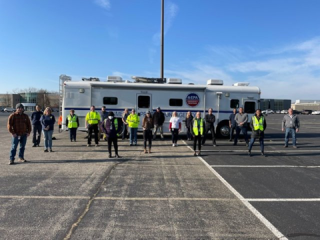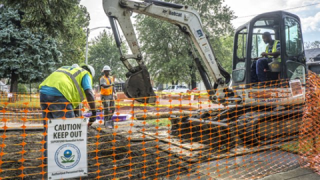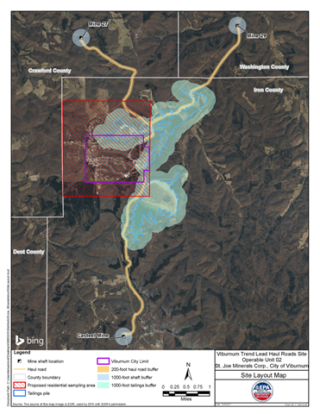Enforcement and Compliance Annual Results for Fiscal Year 2022: Lead
Exposure to lead in environmental media — soil, water, air, and in paint — can cause serious health problems. Those most at risk are children under the age of six, who may suffer severe neurological impacts including learning disabilities, behavioral issues, and hearing loss. Lead-based paint is a significant source of childhood lead poisoning. Other typical sources of lead exposure include lead in drinking water, lead in soil from legacy practices (e.g., leaded gasoline) and some industrial operations, and lead in air emissions from certain commercial sources.
As part of the Agency-wide effort to address lead in the environment, EPA’s enforcement program uses multiple statutory and regulatory authorities, tools, and activities to prevent or reduce exposures to lead. OECA leads and supports a variety of enforcement and compliance assurance activities conducted by EPA Regions and by states, tribes, and territories implementing EPA authorized programs.
In FY 2022, EPA pursued both civil and criminal cases for violations of federal laws to prevent and reduce exposure to lead in paint, drinking water, soils, hazardous waste, and other environmental sources. Many of these enforcement actions and activities addressed lead exposures in communities overburdened by lead and areas with environmental justice concerns. Lead-contaminated dust from chipped or peeling lead-based paint in homes built before 1978 is a common source of childhood exposure. Lead-based paint is the most common source of elevated blood lead levels in U.S. children and reducing childhood exposures to lead is a high priority for EPA. As such, this year the agency took 95 enforcement actions to address noncompliance with laws designed to eliminate lead-based paint exposure in homes. These actions included criminal prosecutions - for example, a New York property manager who failed to disclose known lead paint hazards to prospective tenants was subject to criminal penalties. As part of criminal cases sentenced on Toxic Substances Control Act (TSCA) violations in FY 2022, over 600 victims were identified. This year EPA also took 91 civil actions, like the following two examples, to ensure lead-based paint violations were addressed:
- a property management/development firm in Connecticut agreed to pay a civil penalty of $25,000 to resolve alleged renovation and asbestos violations, including failure to ensure a certified renovator performed or directed the work, in an apartment complex located in an area with environmental justice concerns;
- a construction company, the GB Group, Inc., agreed to pay $137,804 in civil penalties to settle alleged violations of the Lead, Renovation, Repair and Painting (RRP) Rule at residential properties in Oakland (including a building in an area with environmental justice concerns) and San Francisco, California, including failure to assign a certified renovator to each renovation and failure to follow work-site lead-safe practices.

Lead in drinking water presents unique challenges because the lead can leach into water either as it moves through distribution systems, or through plumbing in the building or home. EPA estimates drinking water can make up to 20%or more of a person’s total exposure to lead. However, sensitive subpopulations, such as infants and children, may face higher risks. As part of the Agency’s renewed focus on ensuring regulated public water systems provide safe drinking water, EPA conducted over 160 inspections of water systems, including a number concentrated on assessing Lead and Copper Rule compliance in systems serving overburdened communities. Following an inspection, in November 2021, EPA issued an order to Public Water System in Benton Harbor, Michigan outlining steps necessary for the city to protect residents from exposure to lead and other contaminants through the city’s drinking water. While work continues to replace the lead service lines, the state of Michigan is providing bottled water to residents. In addition, in FY 2022 EPA ramped up its efforts to ensure plumbing products introduced into commerce meet the Safe Drinking Water Act’s stringent lead-free requirements. Among other things, EPA piloted a project with U.S. Customs and Border Protection to target and test such consumer goods.


Lead is the most common contaminant found at Superfund sites across the country and cleanups are often complex, can take years to complete, and generally involve multiple enforcement actions. In FY 2022, EPA issued an order requiring the removal of lead-contaminated soil from 58 residential properties in Viburnum, Missouri. EPA also entered into two agreements to facilitate the cleanup of lead-contaminated soil at the USS Lead Superfund Site in FY 2022.


EPA also engages in outreach and collaboration with the Department of Defense (DOD) and civilian federal agencies to identify how to improve compliance with lead-related environmental regulations that address children’s health, including federal agencies’ work with companies that manage, operate, or maintain privatized housing on federal facilities. For example, in June 2022, EPA presented training, hosted by DOD, on compliance with the Lead Disclosure Rule and RRP Rule that was attended by the 14 private-sector companies that operate DOD’s Military Housing Privatization Initiative projects nationally.
In March 2022, EPA withdrew previously published answers to two Frequently Asked Questions (FAQs) concerning property management companies (PMCs) and their compliance responsibility under TSCA’s RRP Rule. EPA will assess compliance of PMCs with the RRP Rule according to the same requirements placed upon any other entity performing a renovation in target housing. Withdrawal of these FAQs helps to increase the impact and effectiveness of the RRP Rule and improve compliance in rental properties managed by PMCs. This is especially important to underserved and overburdened communities, which often include a high proportion of rental housing managed by PMCs, and the military community, where family housing is also often managed by PMCs.
For more case examples from this year, please visit EPA Enforcement Actions Help Protect Health of Vulnerable Communities from Lead Paint Hazards and explore EPA’s 2022 OECA Lead Bulletin (pdf)
